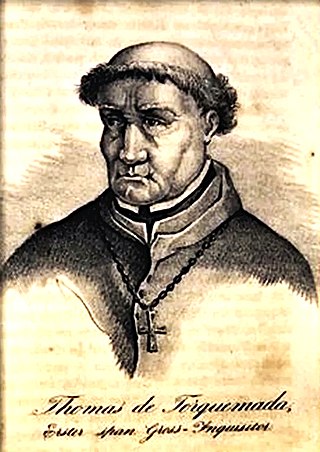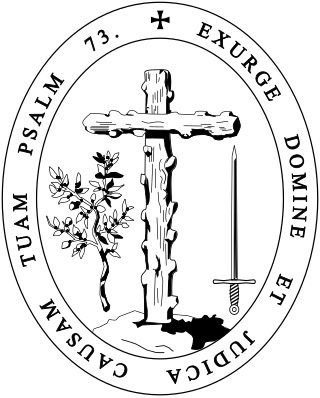Related Research Articles

The Inquisition was a group of institutions within the Catholic Church whose aim was to combat heresy, conducting trials of suspected heretics. Studies of the records have found that the overwhelming majority of sentences consisted of penances, but convictions of unrepentant heresy were handed over to the secular courts, which generally resulted in execution or life imprisonment. The Inquisition had its start in the 12th-century Kingdom of France, with the aim of combating religious deviation, particularly among the Cathars and the Waldensians. The inquisitorial courts from this time until the mid-15th century are together known as the Medieval Inquisition. Other groups investigated during the Medieval Inquisition, which primarily took place in France and Italy, include the Spiritual Franciscans, the Hussites, and the Beguines. Beginning in the 1250s, inquisitors were generally chosen from members of the Dominican Order, replacing the earlier practice of using local clergy as judges.

The Medieval Inquisition was a series of Inquisitions from around 1184, including the Episcopal Inquisition (1184–1230s) and later the Papal Inquisition (1230s). The Medieval Inquisition was established in response to movements considered apostate or heretical to Roman Catholicism, in particular Catharism and Waldensians in Southern France and Northern Italy. These were the first movements of many inquisitions that would follow.

The Malleus Maleficarum, usually translated as the Hammer of Witches, is the best known treatise purporting to be about witchcraft. It was written by the German Catholic clergyman Heinrich Kramer and first published in the German city of Speyer in 1486. Some describe it as the compendium of literature in demonology of the 15th century. Kramer blamed women for his own lust, and presented his views as the Church's position. The book was condemned by top theologians of the Inquisition at the Faculty of Cologne for recommending unethical and illegal procedures, and for being inconsistent with Catholic doctrines of demonology.

Pope Pius V, OP, born Antonio Ghislieri, was head of the Catholic Church and ruler of the Papal States from 7 January 1566 to his death, in May 1572. He is venerated as a saint of the Catholic Church. He is chiefly notable for his role in the Council of Trent, the Counter-Reformation, and the standardization of the Roman Rite within the Latin Church, known as Tridentine mass. Pius V declared Thomas Aquinas a Doctor of the Church.

Pope Gregory IX was head of the Catholic Church and ruler of the Papal States from 19 March 1227 until his death in 1241. He is known for issuing the Decretales and instituting the Papal Inquisition, in response to the failures of the episcopal inquisitions established during the time of Pope Lucius III, by means of the papal bull Ad abolendam, issued in 1184.
The Roman Inquisition, formally Suprema Congregatio Sanctae Romanae et Universalis Inquisitionis, was a system of partisan tribunals developed by the Holy See of the Roman Catholic Church, during the second half of the 16th century, responsible for prosecuting individuals accused of a wide array of crimes according to Roman Catholic law and doctrine, relating to Catholic religious life or alternative religious or secular beliefs. It was established in 1542 by the leader of the Roman Catholic Church, Pope Paul III. In the period after the Medieval Inquisition, it was one of three different manifestations of the wider Catholic Inquisition, the other two being the Spanish Inquisition and Portuguese Inquisition.

Pope John XXII, born Jacques Duèze, was head of the Catholic Church from 7 August 1316 to his death, in December 1334.

Pope Paul IV, born Gian Pietro Carafa was head of the Catholic Church and ruler of the Papal States from 23 May 1555 to his death, in August 1559. While serving as papal nuncio in Spain, he developed an anti-Spanish outlook that later coloured his papacy. In response to an invasion of part of the Papal States by Spain during his papacy, he called for a French military intervention. After a defeat of the French and with Spanish troops at the edge of Rome, the Papacy and Spain reached a compromise: French and Spanish forces left the Papal States and the Pope thereafter adopted a neutral stance between France and Spain.

Tomás de Torquemada, also anglicized as Thomas of Torquemada, was a Castilian Dominican friar and first Grand Inquisitor of the Tribunal of the Holy Office. The Spanish Inquisition was a group of ecclesiastical prelates that was created in 1478, and which was charged with the somewhat ill-defined task of "upholding Catholic religious orthodoxy" within the lands of the newly formed union of the crowns of Castile and Aragon. The lands of this newly formed royal union are now known as the Kingdom of Spain.

Pedro de Arbués, also known as Peter of Arbués was a Spanish Roman Catholic priest and a professed Augustinian canon. He served as an official of the Spanish Inquisition until he was assassinated in the La Seo Cathedral in Zaragoza in 1485 by Jews and conversos. The veneration of him came swiftly through popular acclaim. His death greatly assisted the Inquisitor-General Tomás de Torquemada's campaign against heretics and crypto-Jews. His canonization was celebrated on 29 June 1867.

Peter of Verona, also known as Saint Peter Martyr and Saint Peter of Verona, was a 13th-century Italian Catholic priest. He was a Dominican friar and a celebrated preacher. He served as Inquisitor in Lombardy, was killed by an assassin, and was canonized as a Catholic saint 11 months after his death, making this the fastest canonization in history.
The historical revision of the Inquisition is a historiographical process that started to emerge in the 1970s, with the opening of formerly closed archives, the development of new historical methodologies, and, in Spain, the death of the ruling dictator Francisco Franco in 1975. New works of historical revisionism changed our knowledge of the history of the Roman and Spanish Inquisitions.

The Tribunal of the Holy Office of the Inquisition, commonly known as the Spanish Inquisition, was established in 1478 by the Catholic Monarchs, King Ferdinand II of Aragon and Queen Isabella I of Castile. It began toward the end of the Reconquista and was intended to maintain Catholic orthodoxy in their kingdoms and to replace the Medieval Inquisition, which was under papal control. It became the most substantive of the three different manifestations of the wider Catholic Inquisition, along with the Roman Inquisition and the Portuguese Inquisition. The "Spanish Inquisition" may be defined broadly as operating in Spain and in all Spanish colonies and territories, which included the Canary Islands, the Kingdom of Naples, and all Spanish possessions in North America and South America. According to modern estimates, around 150,000 people were prosecuted for various offences during the three-century duration of the Spanish Inquisition, of whom between 3,000 and 5,000 were executed, approximately 2.7 percent of all cases. The Inquisition, however, since the creation of the American courts, has never had jurisdiction over the Indians. The King of Spain ordered "that the inquisitors should never proceed against the Indians, but against the old Christians and their descendants and other persons against whom in these kingdoms of Spain it is customary to proceed".
Ecclesiastical prisons were penal institutions maintained by the Catholic Church. At various times, they were used for the incarceration both of clergy accused of various crimes, and of laity accused of specifically ecclesiastical crimes; prisoners were sometimes held in custody while awaiting trial, sometimes as part of an imposed sentence. The use of ecclesiastical prisons began as early as the third or fourth century AD, and remained common through the early modern era.
Ad abolendam was a decretal and bull of Pope Lucius III, written at Verona and issued 4 November 1184. It was issued after the Council of Verona settled some jurisdictional differences between the Papacy and Frederick I, Holy Roman Emperor. The document prescribes measures to uproot heresy and sparked the efforts which culminated in the Albigensian Crusade and the Inquisitions. Its chief aim was the complete abolition of Christian heresy.
Vox in Rama is a decretal sent by Pope Gregory IX in June 1233 condemning the heresy of Luciferianism said to be rife in Germany, and authorizing the preaching of a crusade against it. Copies of the letter were sent to Emperor Frederick II, King Henry (VII) of Germany, Archbishop Siegfried III of Mainz, his suffragans, Bishop Conrad II of Hildesheim and the preacher Konrad von Marburg. The copies are dated to 11, 13 and 14 June.

Bernard Délicieux was a Spiritual Franciscan friar who resisted the Inquisition in Carcassonne and Languedoc region of southern France.
Bernard de Caux, or in Latin Bernardo or Bernardus de Caucio, was a Dominican friar and medieval inquisitor. His activities mainly took place in the region of the County of Toulouse between 1243 and 1249. He originated the investigation processes and his witness interrogations are recorded in a 13th-century transcribed manuscript preserved in the library of Toulouse.
The Venetian Inquisition, formally the Holy Office, was the tribunal established jointly by the Venetian government and the Roman Catholic Church to repress heresy throughout the Republic of Venice. The inquisition also intervened in cases of sacrilege, apostasy, prohibited books, superstition, and witchcraft. It was established in the 16th-century and was abolished in 1797.
Internationally, nonreligious people are less likely to support the use of torture against suspected terrorists than Christians, Buddhists, Hindus, Jews, and the adherents of other religions. With the exception of Muslim/African cultures who are most opposed to the use of torture
References
- 1 2 Bishop, J (2006). Aquinas on Torture New Blackfriars, 87:229.
- ↑ Ad extirpanda, quoted at The Roman Theological Forum
- ↑ Herbermann, Charles, ed. (1913). . Catholic Encyclopedia . New York: Robert Appleton Company.
- ↑ New Schaff-Herzog Encyclopedia: II. "The Inquisition in the Middle Ages". Concise historical context of Ad extirpanda
- ↑ Kline, Austin. "Chronology of Medieval Christianity Archived 2013-06-18 at the Wayback Machine ." About.com.